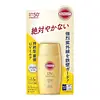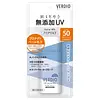What's inside
What's inside
 Key Ingredients
Key Ingredients

 Benefits
Benefits

 Concerns
Concerns

 Ingredients Side-by-side
Ingredients Side-by-side

Water
Skin ConditioningCyclopentasiloxane
EmollientZinc Oxide
Cosmetic ColorantAlcohol Denat.
AntimicrobialEthylhexyl Methoxycinnamate
UV AbsorberIsododecane
EmollientCaprylic Acid
CleansingC12-15 Alkyl Benzoate
AntimicrobialSilica
AbrasiveTrimethylsiloxysilicate
EmollientDiethylhexyl Succinate
EmollientDiethylamino Hydroxybenzoyl Hexyl Benzoate
UV FilterPolysilicone-15
UV FilterBis-Ethylhexyloxyphenol Methoxyphenyl Triazine
Skin ConditioningChamomilla Recutita Flower Extract
MaskingSalvia Officinalis Leaf Extract
CleansingTocopherol
AntioxidantSodium Hyaluronate
HumectantSimmondsia Chinensis Seed Oil
EmollientHydrolyzed Collagen
EmollientButylene Glycol
HumectantBHT
AntioxidantAcrylates/Ethylhexyl Acrylate/Dimethicone Methacrylate Copolymer
Skin ConditioningStearoyl Inulin
EmollientTriethoxycaprylylsilane
Polyhydroxystearic Acid
EmulsifyingLauryl PEG-9 Polydimethylsiloxyethyl Dimethicone
Skin ConditioningSodium Lauroyl Glutamate
Phenoxyethanol
PreservativeWater, Cyclopentasiloxane, Zinc Oxide, Alcohol Denat., Ethylhexyl Methoxycinnamate, Isododecane, Caprylic Acid, C12-15 Alkyl Benzoate, Silica, Trimethylsiloxysilicate, Diethylhexyl Succinate, Diethylamino Hydroxybenzoyl Hexyl Benzoate, Polysilicone-15, Bis-Ethylhexyloxyphenol Methoxyphenyl Triazine, Chamomilla Recutita Flower Extract, Salvia Officinalis Leaf Extract, Tocopherol, Sodium Hyaluronate, Simmondsia Chinensis Seed Oil, Hydrolyzed Collagen, Butylene Glycol, BHT, Acrylates/Ethylhexyl Acrylate/Dimethicone Methacrylate Copolymer, Stearoyl Inulin, Triethoxycaprylylsilane, Polyhydroxystearic Acid, Lauryl PEG-9 Polydimethylsiloxyethyl Dimethicone, Sodium Lauroyl Glutamate, Phenoxyethanol
Cyclopentasiloxane
EmollientWater
Skin ConditioningZinc Oxide
Cosmetic ColorantCetyl Ethylhexanoate
EmollientButylene Glycol
HumectantTitanium Dioxide
Cosmetic ColorantDimethicone
EmollientSilica
AbrasivePEG-9 Polydimethylsiloxyethyl Dimethicone
EmulsifyingCetyl PEG/PPG-10/1 Dimethicone
EmulsifyingHydroxypropyltrimonium Hyaluronate
Secale Cereale Seed Extract
AbrasiveLeontopodium Alpinum Flower/Leaf Extract
Skin ConditioningCentella Asiatica Leaf/Stem Extract
HumectantScutellaria Baicalensis Root Extract
AstringentHydrogen Dimethicone
Aluminum Hydroxide
EmollientSodium Chloride
MaskingDimethicone/Vinyl Dimethicone Crosspolymer
Skin ConditioningSodium Citrate
BufferingTocopheryl Acetate
AntioxidantCitric Acid
BufferingGlycerin
HumectantDisodium Phosphate
BufferingPhenoxyethanol
PreservativeBHT
AntioxidantCyclopentasiloxane, Water, Zinc Oxide, Cetyl Ethylhexanoate, Butylene Glycol, Titanium Dioxide, Dimethicone, Silica, PEG-9 Polydimethylsiloxyethyl Dimethicone, Cetyl PEG/PPG-10/1 Dimethicone, Hydroxypropyltrimonium Hyaluronate, Secale Cereale Seed Extract, Leontopodium Alpinum Flower/Leaf Extract, Centella Asiatica Leaf/Stem Extract, Scutellaria Baicalensis Root Extract, Hydrogen Dimethicone, Aluminum Hydroxide, Sodium Chloride, Dimethicone/Vinyl Dimethicone Crosspolymer, Sodium Citrate, Tocopheryl Acetate, Citric Acid, Glycerin, Disodium Phosphate, Phenoxyethanol, BHT
 Reviews
Reviews

Ingredients Explained
These ingredients are found in both products.
Ingredients higher up in an ingredient list are typically present in a larger amount.
BHT is a synthetic antioxidant and preservative.
As an antioxidant, it helps your body fight off free-radicals. Free-radicals are molecules that may damage your skin cells.
As a preservative, it is used to stabilize products and prevent them from degrading. Specifically, BHT prevents degradation from oxidation.
The concerns related to BHT come from oral studies; this ingredient is currently allowed for use by both the FDA and EU.
However, it was recently restricted for use in the UK as of April 2024.
Learn more about BHTButylene Glycol (or BG) is used within cosmetic products for a few different reasons:
Overall, Butylene Glycol is a safe and well-rounded ingredient that works well with other ingredients.
Though this ingredient works well with most skin types, some people with sensitive skin may experience a reaction such as allergic rashes, closed comedones, or itchiness.
Learn more about Butylene GlycolCyclopentasiloxane, or D5, is a silicone used to improve texture of products and trap moisture.
D5 is considered lightweight and volatile. Volatile means it evaporates quickly after application. Once evaporated, D5 leaves a thin barrier that helps keep skin hydrated.
It is also an emollient. Emollients help soften the skin and prevent water loss. Silicones create a silky texture in products. D5 helps other ingredients become more spreadable.
Studies show D5 is safe to use in skincare products. We recommend speaking with a skincare professional if you have concerns.
Learn more about CyclopentasiloxanePhenoxyethanol is a preservative that has germicide, antimicrobial, and aromatic properties. Studies show that phenoxyethanol can prevent microbial growth. By itself, it has a scent that is similar to that of a rose.
It's often used in formulations along with Caprylyl Glycol to preserve the shelf life of products.
Silica, also known as silicon dioxide, is a naturally occurring mineral. It is used as a fine, spherical, and porous powder in cosmetics.
Though it has exfoliant properties, the function of silica varies depending on the product.
The unique structure of silica enhances the spreadability and adds smoothness, making it a great texture enhancer.
It is also used as an active carrier, emulsifier, and mattifier due to its ability to absorb excess oil.
In some products, tiny microneedles called spicules are made from silica or hydrolyzed sponge. When you rub them in, they lightly polish away dead skin layers and enhance the penetration of active ingredients.
Learn more about SilicaWater. It's the most common cosmetic ingredient of all. You'll usually see it at the top of ingredient lists, meaning that it makes up the largest part of the product.
So why is it so popular? Water most often acts as a solvent - this means that it helps dissolve other ingredients into the formulation.
You'll also recognize water as that liquid we all need to stay alive. If you see this, drink a glass of water. Stay hydrated!
Learn more about WaterZinc Oxide is a mineral broad-spectrum UV filter; it is the broadest UVA and UVB reflector approved by the FDA. It also has skin protectant and skin soothing properties.
Zinc oxide is one of the most effective broad-spectrum UV filters. It protects against UVB, UVAII, and UVAI. In comparison to its counterpart titanium dioxide, zinc oxide provides uniform and extended UVA protection.
Another great benefit? This ingredient is highly photostable so it won't degrade easily under sunlight.
A common myth is that mineral UV filters are widely believed to primarily reflect UV light.
However, modern research shows titanium dioxide absorbs UV radiation like chemical filters (~95% absorption & 5% reflection).
Zinc oxide has great skin soothing properties so you'll likely find this in sunscreens formulated for sensitive skin or babies/children. It is unlikely to cause "eye sting" like other sunscreen ingredients.
Regulatory agencies consider zinc oxide to be non-toxic and safe. It has also been shown to not penetrate the skin.
Unfortunately, this ingredient does leave a visible white cast. This is why mineral sunscreens are often less cosmetically elegant than chemical or hybrid ones.
In cosmetics, zinc oxide can be found in both non-nano and nano-sized forms. The nano version is used to reduce white cast and improve the texture of sunscreen formulas.
There are ongoing concerns surrounding nano-zinc oxide's impact on marine ecosystems and whether it can be absorbed into skin.
Regarding marine ecosystems and coral reefs, there is no conclusive evidence that any form of zinc oxide (or any other sunscreen ingredients) will cause harm. The science is still developing but many consumers are keeping a close eye on this issue.
Please note, many destinations have reef-safety sunscreen rules. For instance, the U.S. Virgin Islands advises all visitors to use non-nano mineral sunscreens.
There has also been some stir about whether micronized or nano zinc oxide has potential photoxicity and absorption through the skin/lungs.
An in-vitro (done in a test tube or petri dish) study demonstrated micronized zinc oxide to have potential phototoxicity. There's no need to fret; the EU Commission's Scientific Committee on Consumer Safety has stated, "The relevance of these findings needs to be clarified by appropriate investigations in vivo." Or in other words, further studies done on living organisms are needed to prove this.
Current research shows zinc oxide nanoparticles do not penetrate intact or sunburned skin. They either remain on the surface or in the outermost layer of dead skin (stratum corneum).
Zinc oxide is one of only two classified mineral UV filters with titanium dioxide being the other one.
Fun fact: Zinc has been used throughout history as an ingredient in paint and medicine. An Indian text from 500BC is believed to list zinc oxide as a salve for open wound. The Ancient Greek physician Dioscorides has also mentioned the use of zinc as an ointment in 1AD.
Learn more about Zinc Oxide